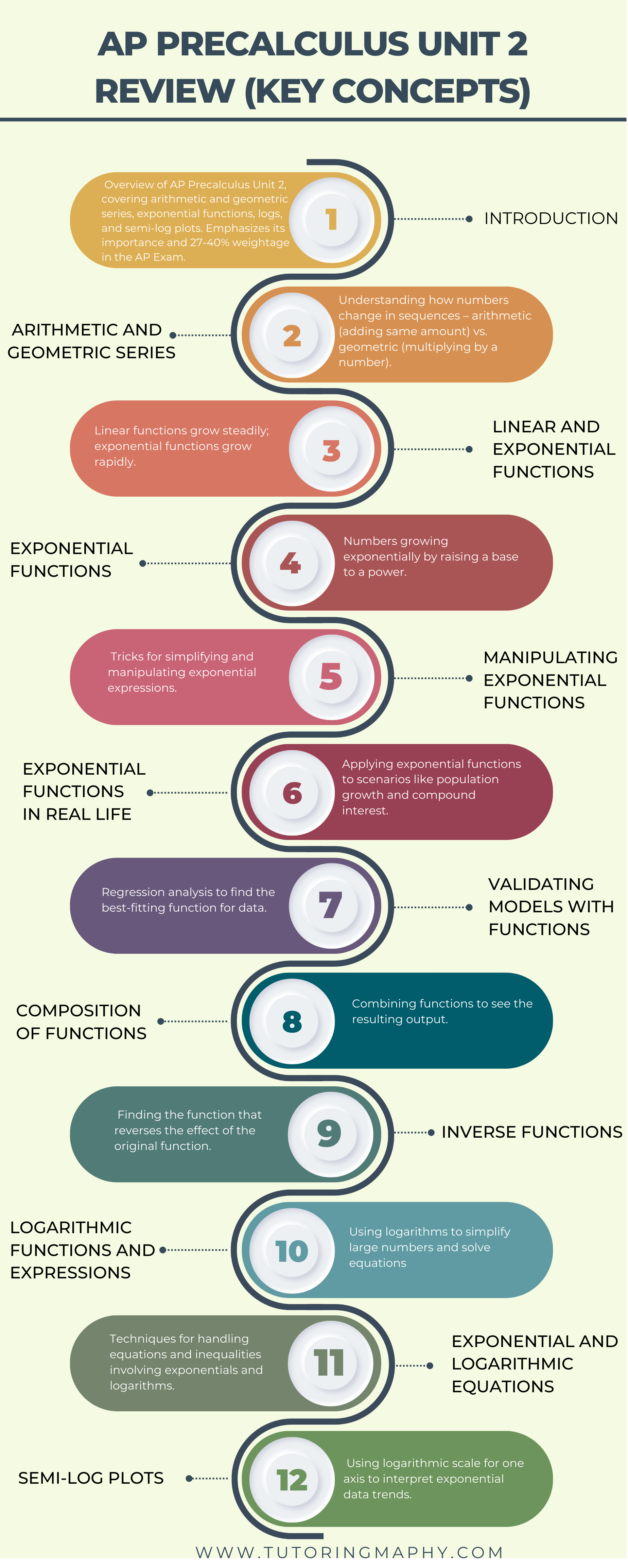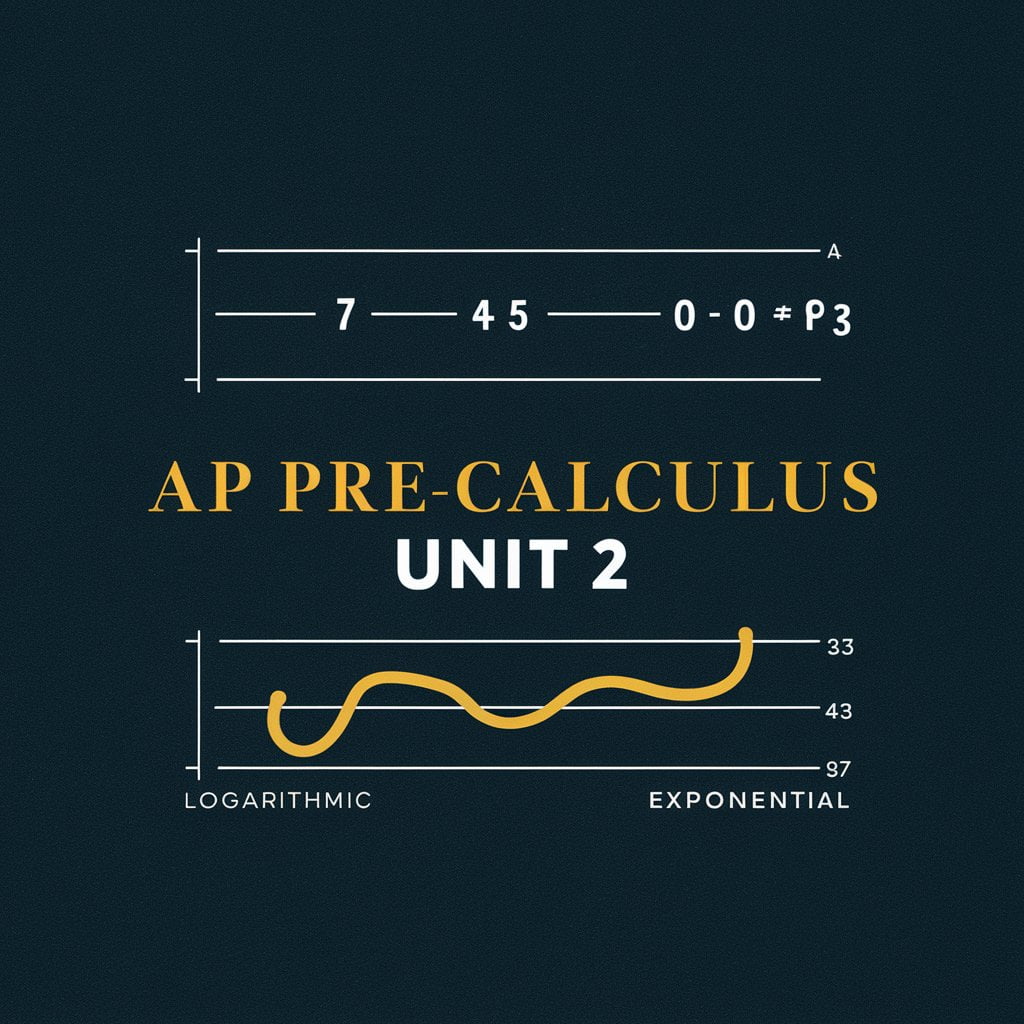-
I. Introduction: Brief overview of AP Precalculus Unit 2
- 2.1. Change in Arithmetic and Geometric series
- 2.2 Change in Linear and Exponential Functions
- 2.3 Exponential functions
- 2.4 Exponential Function Manipulation
- 2.5 Exponential Function Context and Data Modeling
- 2.6 Competing Function and Model Validation
- 2.7 Composition of Functions
- 2.8 Inverse Functions
- 2.9 Logarithmic Expressions
- 2.10 Inverses of Exponential Functions
- 2.11 Logarithmic Functions
- 2.12 Logarithmic Function Manipulation
- 2.13 Exponential and Logarithmic Equations and Inequalities
- 2.14 Logarithmic Function Context and Data Modeling
- 2.15 Semi-log Plots
- II. AP Precalculus unit 2 Practice
I. Introduction: Brief overview of AP Precalculus Unit 2
In AP Precalculus Unit 2, we’re talking about arithmetic and geometric series, exponential functions, logs, and semi log plots. Basically, it’s all about understanding how numbers behave and how they’re connected. You know, like when you add up numbers in a sequence or when things grow or shrink over time. And those graphs? They help us visualize data and see trends. This unit is super important because it sets the stage for tackling more complex math later on and builds on AP Precalculus Unit 1. This Unit requires about 6-9 weeks of prep time and covers 27-40% of AP Exam weightage
2.1. Change in Arithmetic and Geometric series
In AP Precalculus Unit 2, we have this thing called “Change in Arithmetic and Geometric Series” in 2.1. It’s all about getting to know about how numbers change in sequences. Picture it like this: Imagine you’re counting money, but instead of just adding the same amount each time (that’s your arithmetic series), sometimes you’re multiplying by a certain number to get the next amount (that’s your geometric series). It’s like going from counting coins to counting dollar bills! This unit is all about understanding those different ways numbers change and how we can use that to solve all sorts of problems
2.2 Change in Linear and Exponential Functions
AP Precalculus Unit 2 Review, we’re checking out “Change in Linear and Exponential Functions” in 2.2. It’s like learning how things grow or shrink over time, but in different ways. Think of it like this: Linear functions are like climbing stairs – you go up by the same amount each time. But exponential functions? They’re more like riding a rocket to space – you start off slow but then zoom off super-fast! This unit is all about wrapping our heads around those different kinds of growth and how we can use them to understand the world around us.
2.3 Exponential functions
Let’s talk about exponential functions. They’re kind of a big deal in high school math. Picture this: you’ve got a number, let’s call it “x”, and you raise it to some power, like 2 or 3. That’s your exponential function! It’s like magic – the number just keeps getting bigger and bigger the more you raise it to the power. Think of it like a snowball rolling down a hill – it starts off small, but as it rolls, it picks up more snow and gets bigger and bigger. Exponential functions are like that, but with numbers instead of snow. They show up all over the place in real life, like when things grow exponentially, or decay over time. So yeah, exponential functions may seem tricky at first, but once you get the hang of them, they’re pretty cool!
2.4 Exponential Function Manipulation
“Exponential Function Manipulation” is 2.4 in AP Precalculus Unit 2. It’s like tinkering with the rules of exponential functions to make them do what you want. Sometimes, you wonder if you can simplify exponential expressions or change it around. That’s what this unit is all about! You learn all these tricks, like how to multiply them together, divide them, or even raise one to the power of another. It’s kind of like playing with a Rubik’s Cube – you twist and turn until everything lines up just right.

2.5 Exponential Function Context and Data Modeling
It’s all about taking those exponential functions we’ve been learning about and applying them to real-life situations. Think of it like using math to make sense of the world around us. We’re talking about stuff like population growth, compound interest, and even radioactive decay. You learn how to take data and use exponential functions to model it, so you can make predictions or understand how things change over time. It’s pretty nice to see how math can help us understand the world in such a practical way.
2.6 Competing Function and Model Validation
This part of the AP Precalculus Unit 2 is all about trying out different functions and models to see which one fits the data best. It’s like trying on different outfits to find the perfect fit. IN fancy words, this is called regression analysis. You’ve got all these math functions, like linear functions, exponential functions, Quadratic functions and more, and you’re trying to figure out which one suits the data the best. After you’ve found a potential winner, you gotta put it to the test of residuals – they’re like your trusty sidekicks.
2.7 Composition of Functions
It’s like stacking up functions and seeing what happens when you combine them. Picture it like making a math sandwich – you’ve got one function as the bread and another as the filling, and when you put them together, you get a whole new flavor! It’s all about taking the output of one function and feeding it into another to see what comes out. You learn how to follow the chain of transformations and see how each function affects the final result. It’s pretty neat to see how you can mix and match functions to create new mathematical pieces.
2.8 Inverse Functions
“Inverse Functions” is an important concept for AP Calculus AB and BC as well. This is where things get flipped around! So, you’ve got a function that takes an input and gives an output, right? Well, the inverse function does the opposite – it takes that output and gives you back the original input. It’s like pressing the rewind button on a movie and watching everything go backward. You learn how to find the inverse of a function and how to use it to undo the effects of the original function. You will see questions based on graphs and tabular form as well.
2.9 Logarithmic Expressions
Logarithmic Expressions” is an important aspect in AP Precalculus. You could expect this in AP Precalculus FRQ Type 4. You know how exponents are all about making numbers bigger? Well, logarithms do the opposite – they help you break down big numbers into smaller pieces. You learn how to use logarithms to solve equations, figure out growth rates, pH levels, Earthquake intensity and even measure sound levels. We also use sum, difference and some other properties of log to condense or expand log expressions.
Curious about reliable resources of AP Precalculus? Checkout Top 10 books for AP Precalculus
2.10 Inverses of Exponential Functions
“Inverses of Exponential Functions” is where we flip the script on those exponential functions we’ve been dealing with. So, you know how exponential functions make numbers grow super-fast? Well, their inverses are like the brakes – they slow things down and bring them back to normal. You learn how to find the inverse of an exponential function and how to use it to solve equations and understand growth rates in reverse, value of depreciating assets, rate of dissolution of a medicine in body etc.
2.11 Logarithmic Functions
“Logarithmic Functions help us break down those big numbers into smaller, more manageable pieces. We learn how to find domain and range of logs. We will also learn how to use logarithmic functions to solve various sorts of problems, like figuring out how long it takes for something to double in size or how loud a sound is, various real-life models like spreading of a humor.
2.12 Logarithmic Function Manipulation
This part is like taking those logarithmic functions and giving them a makeover – we’re tinkering with them to make them do what we want. Remember the transformation rules we discussed earlier – Translations, Reflections, Dilations etc? Now is the time to apply those rules in logs. However, this time we will see how the log function will change if we change base, if we raise it to a power etc. – in other words not as straight forward.
2.13 Exponential and Logarithmic Equations and Inequalities
We’re dealing with equations and inequalities that involve tricky functions like exponentials and logarithms. This might involve taking logs both sides to simplify, or taking anti log both sides to find the unknown. We also need to make sure the inequalities signs are dealt accordingly. If we multiply equation with a negative, it flips!
2.14 Logarithmic Function Context and Data Modeling
This can be used to model stuff where things grow proportionally, or you keep multiplying stuff over and over again. It’s like when you see something grow by the same amount every time, but in intervals.
Building a logarithmic function model can be done using given input-output pairs, and solving for unknown. However, you can even use logarithmic regressions to build your model using TI-84 inspire or TI-84 plus.
2.15 Semi-log Plots
Semi-log plots are a handy tool in the world of data visualization, especially when dealing with data that covers a wide range of values. Instead of using regular Cartesian coordinates where both the x and y axes increase linearly, semi-log plots use a logarithmic scale for just one of the axes. Typically, it’s the y-axis that gets the logarithmic treatment, while the x-axis remains linear. This setup allows us to display data that grows exponentially in a way that’s easier to interpret visually. It’s like stretching out the graph paper in just the right way so that those big jumps in data become more manageable. By using semi-log plots, we can spot trends and patterns in the data more easily, making it a valuable tool.
II. AP Precalculus unit 2 Practice
Running out of practice questions on AP Precalculus Unit 2? Check out
What Next – Get inspired to prepare for SAT! Here are 6 Reasons to take SAT even if it’s optional



